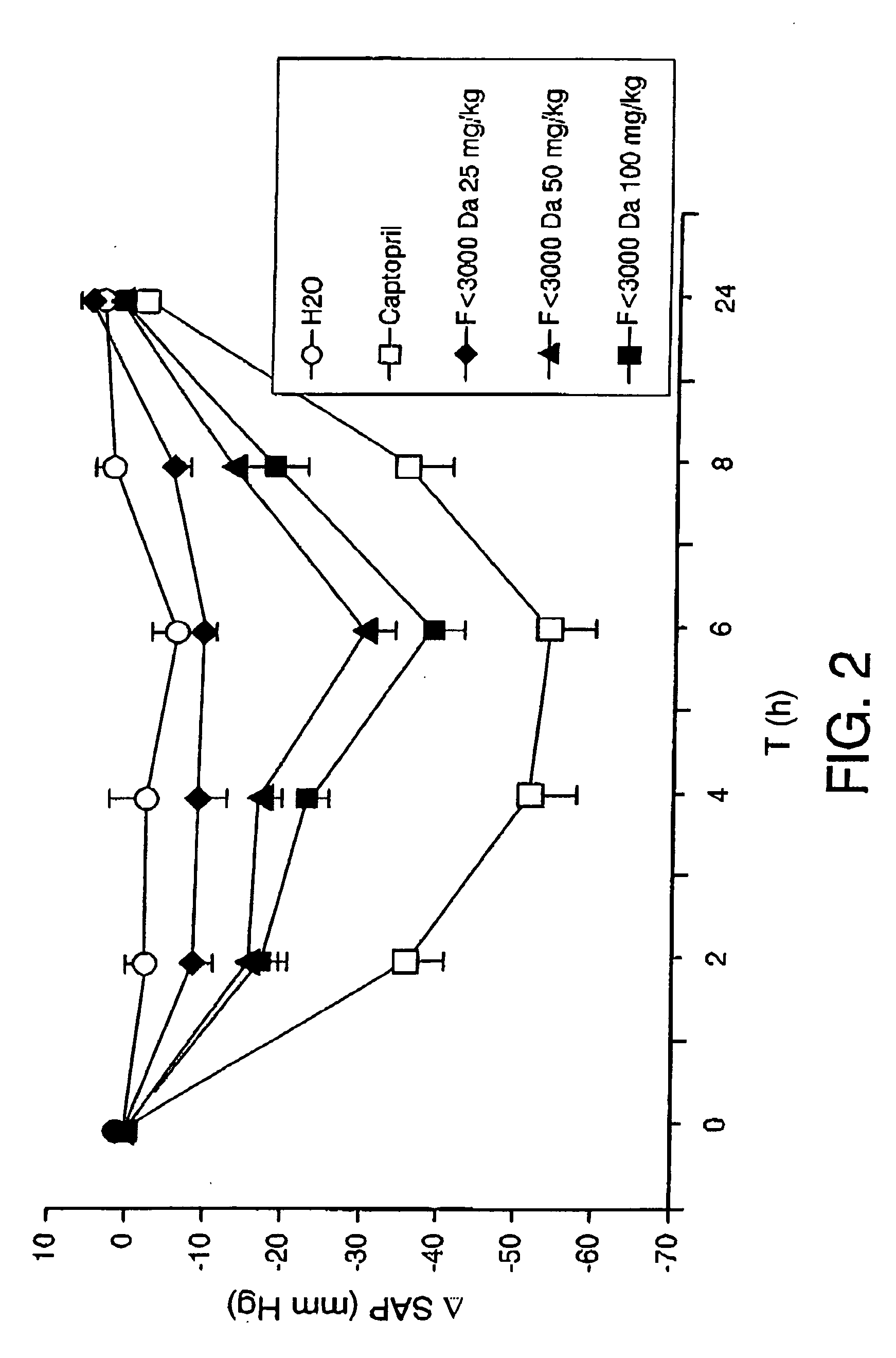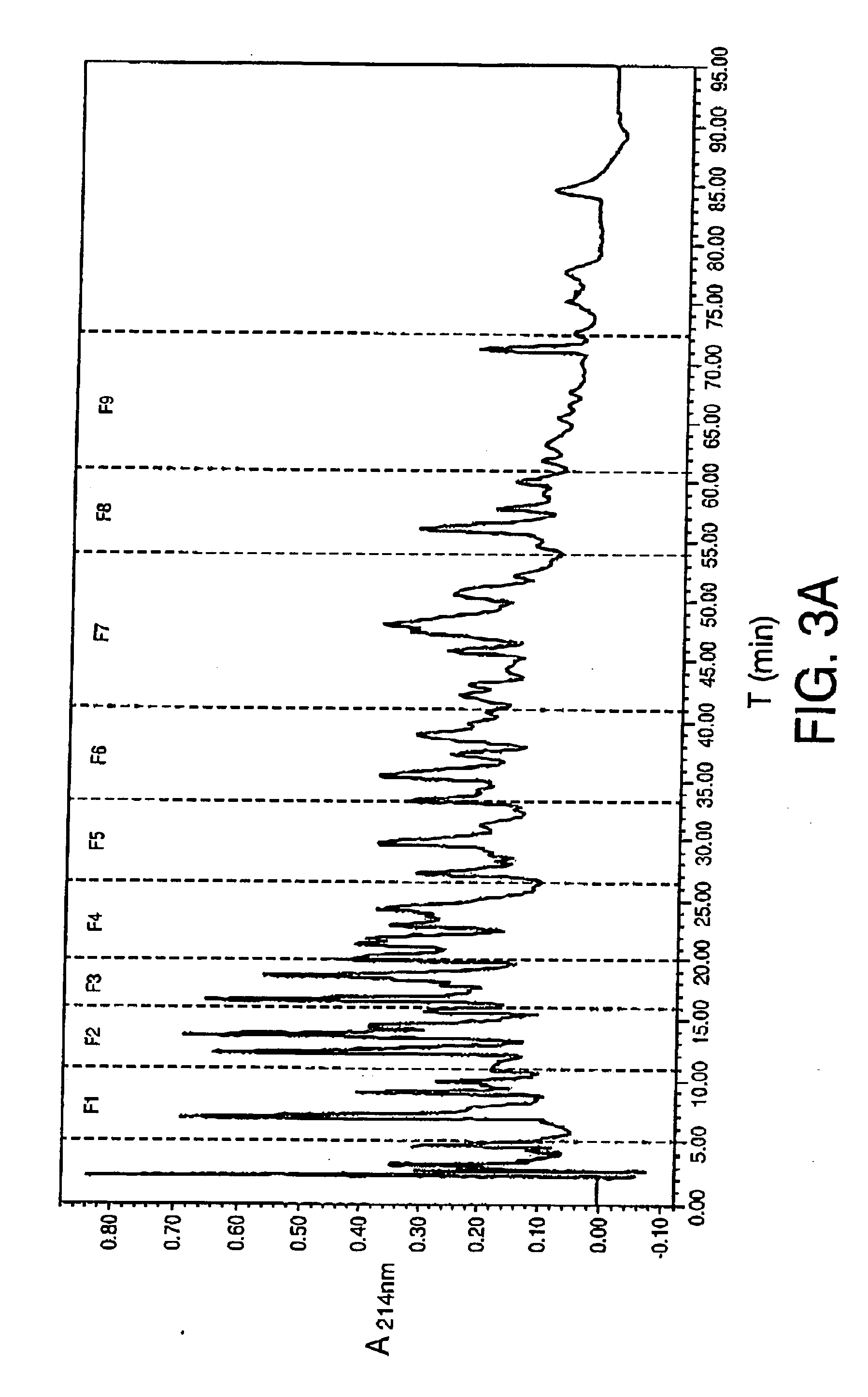Bioactive peptides derived from the proteins of egg white by means of enzymatic hydrolysis
a technology of enzymatic hydrolysis and bioactive peptides, which is applied in the direction of peptides, drug compositions, cardiovascular disorders, etc., can solve the problems of high pressure conditions and strong irrruptive functional foods in the food sector, and achieve the effect of expanding the application of egg proteins
- Summary
- Abstract
- Description
- Claims
- Application Information
AI Technical Summary
Benefits of technology
Problems solved by technology
Method used
Image
Examples
examples of embodiment
OF THE INVENTION
[0055] The following examples illustrate the invention, though they must not be regarded as limiting the scope thereof.
example 1
Obtaining of Bioactive Peptides, with ACEI and Anti-Hypertensive Activity, Starting from Egg White Hydrolysed with Pepsin at Atmospheric Pressure
[0056] The hydrolysate was obtained using as substrate chicken egg white coming from fresh eggs, separated from the yolk and freeze-dried. As enzyme, pepsin was used (E.C. 3.4.23.1 type A, 10000 U / mg of protein) coming from pig stomach (Sigma). The substrate was dissolved in water at a concentration of 100 mg / ml and the pH was adjusted to 2.0 adding 1N HCl. Pepsin was added (enzyme / substrate ratio 1 / 100, w / w). The hydrolysis was conducted at a temperature of 37° C. for 24 hours, at atmospheric pressure (0.1 MPa). The deactivation of the pepsin was achieved by raising the pH to 7.0 with 1N NaOH.
[0057] The ACEI activity was measured in aliquots collected following different hydrolysis times, 0, 30 minutes, 3, 5, 8 and 24 hours. The results showed that unhydrolysed egg white did not possess ACEI activity (IC50>750 μg / ml) but it actively inhi...
example 2
Peptides Obtained by Means of Chemical Synthesis with ACEI and Anti-Hypertensive Activity
[0063] All the identified peptides mentioned in Table 2 of example 1 were chemically synthesised by means of the Fmoc method in solid phase with a model 431A synthesiser from Applied Biosystems Inc. (Überlingen, Germany). The purity of the synthetic peptides was verified by mean of RP-HPLC-MS / MS.
[0064] The ACEI activity of the synthetic peptides was measured. The activity found is shown in table 3.Standing out for their activity are 8 peptides with IC50 less than 450 μM and above all the sequences: SEQ. ID. No 2, SEQ. ID. No 3, SEQ. ID. No 5 and SEQ. ID. No 6 with IC50 less than 34 μM.
TABLE 3ACEI activity of peptides identified insubfractions 6, 7 and 8 of the fractionless than 3000 Da of egg white hydro-lysed with pepsin for three hoursSequence NoAmino acidsIC50 (μM)SEQ. ID. No 1YQIGL173.8SEQ. ID. No 2IVF33.9SEQ. ID. No 3RADHPFL6.2SEQ. ID. No 4FSL172.9ESIINF>1000SEQ. ID. No 5FRADHPFL3.2SEQ....
PUM
| Property | Measurement | Unit |
|---|---|---|
| Time | aaaaa | aaaaa |
| Time | aaaaa | aaaaa |
| Time | aaaaa | aaaaa |
Abstract
Description
Claims
Application Information
 Login to View More
Login to View More - R&D
- Intellectual Property
- Life Sciences
- Materials
- Tech Scout
- Unparalleled Data Quality
- Higher Quality Content
- 60% Fewer Hallucinations
Browse by: Latest US Patents, China's latest patents, Technical Efficacy Thesaurus, Application Domain, Technology Topic, Popular Technical Reports.
© 2025 PatSnap. All rights reserved.Legal|Privacy policy|Modern Slavery Act Transparency Statement|Sitemap|About US| Contact US: help@patsnap.com



